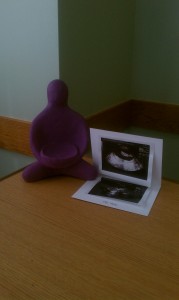By Janet Callahan
Not every pregnancy goes according to plan.
After 5 years of on-again, off-again fertility treatments, my son came crashing into the world by emergency c-section at 27 weeks and a day, weighing only a pound and seven ounces, thanks to pre-eclampsia and HELLP syndrome. With that kind of delivery, there isn’t time for setting the mood – no candles, no soft music, no labyrinth or birthing tub….just panic. The spiritual side of that sort of birth defaults to praying, “Goddess, save us – save me, save my baby, get us through this, I want us to live.”
My son had many medical challenges, and spent 291 days in the NICU. Most of his issues were things that would improve as he grew; therapy would resolve many others, or at least keep them from interfering with his life as he grows up.
My husband Barry and I knew that any subsequent pregnancy would be high risk. We weighed our options, and decided to try one more time, hoping that a second pregnancy would go more smoothly. The high risk team that I consulted with told me that statistically, about 30% of women re-develop pre-eclampsia, and that even then, it might be later in the pregnancy or might not be as bad (so that the pregnancy could be extended, rather than delivering within hours or days of the diagnosis). They offered some suggestions to improve our odds, like taking baby aspirin.
We had always intended to have more than one child, and we figured we had a reasonable chance at a more normal pregnancy the second time around, so after a lot of meditation and prayer and talking and thinking, we decided to give it a shot. Surprisingly, we got pregnant our second month of trying, without any fertility drugs – much sooner than we’d intended to, but a blessing none the less.
I knew that the medical team would likely put me on bed rest at the first signs of trouble in my second pregnancy. I was seeing either my own OB or the high risk team every 2 weeks starting at the very beginning of my pregnancy. Sure enough, at 23 weeks and 6 days, my blood pressure skyrocketed, and I was admitted to labor and delivery to be stabilized, with hopes of moving me to the antepartum unit for as long as we could manage to keep me and the baby safe.
We had the most horrifying discussion of my entire life that first day – the kind of thing that sounds like it belongs in a movie, not real life. The NICU sent a doctor down to talk to us. After a bit, she realized that she’d treated my son, and she knew the issues we’d faced with him. The discussion went from hard facts – survival rates, average time in NICU, etc. – to, “you’ve done this before, and you’re so much earlier this time – right on the edge of viability – do you want to fight for this baby if things take a turn for the worse this week?” I couldn’t believe she would ask if I wanted to let my baby die. The baby we’d prayed for, done fertility spells for – the baby we wanted so much.
Of course we wanted to fight. The fight would start out to stay pregnant as long as possible, because the further we made it, the fewer issues and less time in the NICU (hopefully). But if we weren’t able to keep her growing safely inside, we’d fight for her on the outside.
I moved into a small private room – a bed, a night stand full of fetal monitoring equipment, a chair, and in the shelves on the wall, a small refrigerator, a TV, a small cabinet for a closet. At least I had my own bathroom. There was barely room for my son’s stroller; more than once we put him on my bed and parked his stroller in my bathroom to have space for the nurses to check my blood pressure or take blood.
Initially, there was talk of sending me home for the rest of my bed rest, but another blood pressure spike (and another overnight stay in triage) just a few days later ended that idea. We all started to get used to the idea that I was going to be in the hospital for a while – hopefully weeks, or even months, giving my baby time to grow as much as possible.
The whole thing was rather surreal.
Being in the hospital is hard. There are routines to learn, names and faces to match up, doctors to see. And there’s little you can do to control the situation – especially on bed rest.
After a few days, I realized that I was going to need to figure out what to do with myself during this extended break. Sure, I could sit and watch shows about ancient aliens on the history channel and all the birth and baby stories on The Learning Channel (but frankly, those were more horrifying than anything, given my precarious position)…but I felt like I ought to be at least a little productive while I was doing nothing.
And so, the idea of turning it into something of a spiritual retreat came to me.
I am, for the most part, a Type A mom. I work full time as an engineer. I have a young child with medical challenges – when I was on bed rest, we still had private duty nursing for him 18 hours a day, he had multiple therapy appointments each week, and at least two doctor appointments a month. I’m a writer and an artist. I’m a wife, a friend, and I try to be active in my community. There’s a lot going on in my day-to-day life, and I’m not always good at taking care of myself.
But here I was, in the midst of a golden opportunity. I could get up to go to the bathroom and I could take a shower each day, but other than that, I was supposed to sit or lie around and let them bring me whatever I needed. Meals were brought by the cafeteria. Snacks were available upon request. The bathroom was 6 steps away. I did not have to – in fact, could not – care for my son, my husband, my employer, or anyone else. The view out my window wasn’t great (a gravel rooftop with HVAC units, surrounded by the hospital’s other towers), but I could see the sky and watch the weather. Friends brought live plants – mostly flowers – to decorate the large window sill and brighten up the room.
So, I set out to create the retreat I should have had ages ago.
The first step in taking care of myself was sleep – something I was decidedly short on when I entered the hospital. I napped at least once a day, and then slept from midnight until my 6 am blood pressure check. I was somewhat forced to catch up on sleep thanks to the large quantities of medications I was taking to keep my blood pressure at a reasonable number.
My daily shower became a ritual bath. Besides it being the only time I wasn’t covered in ultrasound gel (I had fetal monitoring at least twice a day, ultrasounds 3 days a week, and another ultrasound if anything on the fetal monitoring strip was unexpected), it was the only time I was guaranteed silence and not being interrupted. It was a time to release stress with the flowing water, and to ground and center and shield from the stream of people in and out of my little room.
I took up a daily meditation practice – something I’ve rarely managed to do more than a few days at a time. After lunch I’d sit and meditate until I was interrupted, usually an hour or so later when they came to collect my lunch tray, but sometimes for meds or for yet another doctor to stop by.
Between my meditation time and dinner, I tried to write every day (but some days, bad TV won out). I spent time thinking about what I wanted life to be like moving forward, and journaling about how things were and how I wanted them to be. I did some hand-sewing, and went through several puzzle books in my time in the hospital, focusing on being mindful of what I was doing.
 I built a small altar on my nightstand – a Goddess statue, with a growing pile of ultrasound photos of the life growing within me. That same statue, with a few additions, followed my daughter to the NICU, and then home (and then back to the PICU shortly after that when she caught a respiratory virus).
I built a small altar on my nightstand – a Goddess statue, with a growing pile of ultrasound photos of the life growing within me. That same statue, with a few additions, followed my daughter to the NICU, and then home (and then back to the PICU shortly after that when she caught a respiratory virus).
All told, I had 30 days of peace. A month of working on accepting that this pregnancy, too, was not going as planned, and a month of listening to my baby’s heartbeat several times a day and seeing her on ultrasound several times a week.
Not that there weren’t frantic episodes that broke that peace during the month – every time the baby’s heart rate wasn’t behaving, we were off to triage for closer monitoring; every time my blood pressure spiked it was off to triage with another IV to force medications in to bring things back under control. But it was, all in all, a restful time.
We all knew it was just a matter of time, though, before delivery. My OB wanted to make it to thirty three weeks; the high risk team was originally going to be happy with twenty six weeks. But week twenty seven came with more glitches in the numbers than previous weeks, and we all knew that as the blood pressure med doses went up, the risk of other issues went up as well; we reached a point one day where I was sent to triage for extra monitoring of the baby’s heart rate, and my blood pressure spiked while I was there. We all agreed it was time to be done, and I had one last night to say my prayers, meditate, and send Reiki to my child and myself, and the next morning we were off to the OR at twenty eight weeks and one day.
While my daughter’s birth was not the birth experience I had hoped for, I was in a good place for it – grounded, centered, aware we’d done everything possible to give her the best chance at a future free of complications from her early birth, and at peace with the way things played out. I went into my maternity leave feeling much more connected to my Gods than I had with my son’s birth.
And while I haven’t managed to keep up the daily meditation practice, I’m still much more aware of needing to take care of myself as we have navigated this first crazy year with a second child with complex medical issues.
Janet Callahan is a priestess, wife, and mother of two complicated former preemies living near Detroit. She has a day job as an engineer, but has finally decided that she wants to be a writer and artist when she grows up. You can find all of her projects at http://www.janetcallahan.com.
















